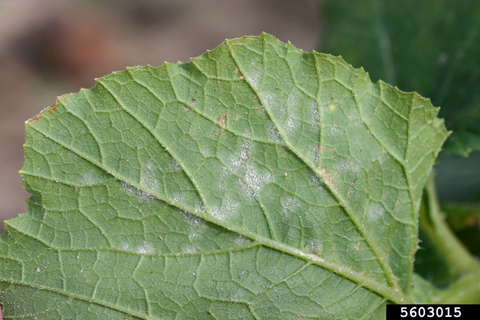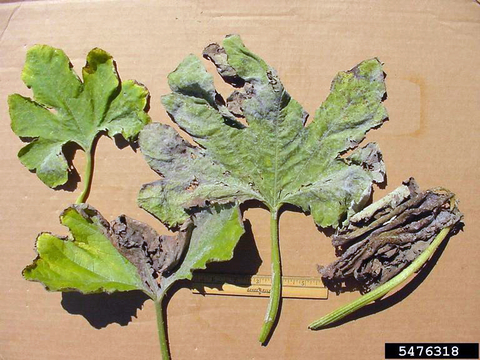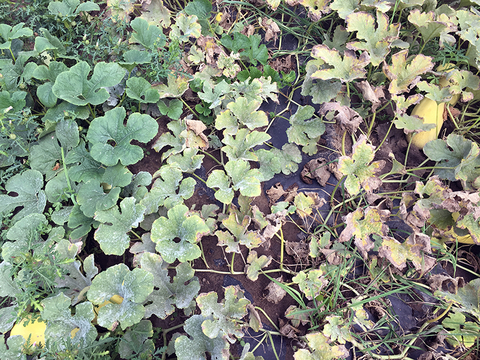Quick facts
- White powdery spots can form on both upper and lower leaf surfaces, and quickly expand into large blotches.
- Symptoms of powdery mildew first appear mid to late summer in Minnesota.
- Powdery mildew weakens the plant and the fruit ripens prematurely. Infected plants produce fewer and smaller fruit.
- In warm, dry conditions, new spores form and easily spread the disease.
- Provide good air movement around plants through proper spacing, staking of plants and weed control.
- If susceptible varieties are growing in an area where powdery mildew has resulted in yield loss in the past, fungicide applications may be necessary.
How to tell powdery mildew from other cucurbit issues
- The first sign of powdery mildew is pale yellow leaf spots.
- White powdery spots can form on both upper and lower leaf surfaces, and quickly expand into large blotches. The large blotches can cover the entire leaf, petiole and stem surfaces.
- When powdery mildew infects the majority of the foliage, the plant becomes weak and the fruit ripens prematurely. Fruit can become sunburned.
Biology
- Powdery mildew, mainly caused by the fungus Podosphaera xanthii, infects all cucurbits, including muskmelons, squash, cucumbers, gourds, watermelons and pumpkins.
- Powdery mildew infections favor humid conditions with temperatures around 68-81° F.
- In warm, dry conditions, new spores form and easily spread the disease.
- Symptoms of powdery mildew first appear mid to late summer in Minnesota. The older leaves are more susceptible and powdery mildew will infect them first.
- Wind blows spores produced in leaf spots to infect other leaves.
- Under favorable conditions, powdery mildew can spread very rapidly, often covering all of the leaves.
- Although powdery mildew primarily infects leaves and vines, infections occasionally occur on cucumber or melon fruit. Powdery mildew does not directly infect squash fruit.
- Fewer and smaller fruit grow on infected plants. Reduced fruit quality occurs due to increased sunscald, incomplete ripening, poor storability and poor flavor.
- Powdery mildew is more likely to infect densely planted vines, plants crowded by weeds, plants in shaded sites and over-fertilized plants.
Managing powdery mildew in the home garden
- Plant varieties with complete or partial resistance to powdery mildew.
- Provide good air movement around plants through proper spacing, staking of plants and weed control.
- Proper spacing at planting is important, a guide for proper spacing can be found in our vining vegetable growing guide.
Managing downy mildew on farms
|
- In Minnesota, powdery mildew typically arrives in mid- to late-summer. Plants that have already begun to produce fruit are typically impacted first.
- Scout your fields to detect powdery mildew before it spreads: Once a week, examine five mature leaves for powdery mildew infection. In large plantings, repeat at 10 different locations in the field.
- Fungicide sprays should start being made when you find that one out of the fifty scouted leaves has powdery mildew.
Find plant varieties with complete or partial resistance to powdery mildew on the Cornell University site.
- Apply fertilizer based on soil test results. Avoid over-applying nitrogen.
- Provide good air movement around plants through proper spacing, staking of plants and weed control.
- If susceptible varieties are growing in an area where powdery mildew has resulted in yield loss in the past, fungicides may be necessary.
- Monitor for the presence of powdery mildew, and start fungicide treatments when disease is first found.
Commercial growers should refer to the Midwest Vegetable Production Guide for pesticide recommendations. Note that powdery mildew is constantly evolving new resistances, so review current recommendations before each season.
CAUTION: Mention of a pesticide or use of a pesticide label is for educational purposes only. Always follow the pesticide label directions attached to the pesticide container you are using. Be sure that the plant you wish to treat is listed on the label of the pesticide you intend to use. And observe the number of days between pesticide application and when you can harvest your crop. Remember, the label is the law.
Reviewed in 2022




